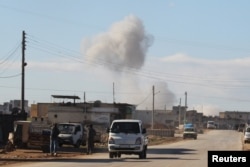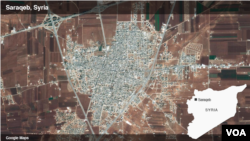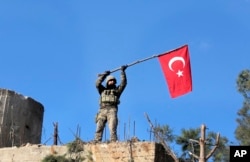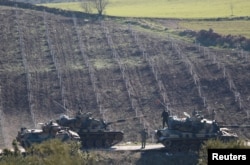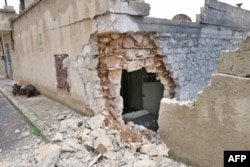Nearly 200 civilians have reportedly been killed in Syrian government airstrikes launched in the past 37 days as part an offensive to retake territory in the northwest province of Idlib, the last province in the war-torn country remaining in the hands of insurgents battling to topple President Bashar al-Assad.
The Syrian Observatory for Human Rights, a Britain-based organization that relies on information gathered by on-the-ground spotters, say among the dead are 50 children and 36 women and that civilian facilities are clearly being targeted, including makeshift clinics and market places.
Political activists say they have recorded more than 96 air raids, some involving the dropping of crude, but powerful barrel bombs, in the southern and eastern countryside of Idlib.
Video posted online of the aftermath of one marketplace attack captures a picture of panic with White Helmet rescue workers frantically digging away rubble to free injured civilians. The White Helmets have accused Syrian warplanes of dropping banned cluster munitions on farmland “to prevent families from farming.”
Government helicopters dropped barrel bombs Wednesday on the villages of Tell-es-Sultan and Barissa, say activists. And the local council in Saraqeb reported the town has suffered “massive destruction resulting from the relentless bombing campaign by the Assad regime and Russian warplanes.” The council said most of Saraqeb’s main civilian facilities, including medical centers and bakeries, have been destroyed.
The weeks-long government offensive has forced tens of thousands of civilians to flee towards the border with Turkey, according to humanitarian groups, but they are having to contend not only with harsh winter weather, but also to dodge fighting on an increasingly complex battlefield featuring forces loyal to the Assad regime, including foreign Shi’ite fighters, and a mixed bag of rebel militias, including al-Qaida-linked Tahrir al-Sham, working alongside Turkey.
To the north, a Turkish incursion launched more than a week ago, and backed by Syrian rebel militias, into the Kurdish enclave of Afrin, is complicating where refugees can go to seek safety. The Turkish intervention has prompted fierce fighting with much of the focus on a strategic hill near Azaz that has changed hands, reportedly, several times since January 22 between the Turkish military and Kurdish militiamen.
To add to the complexity, Turkey sent a detachment of more than 40 armored vehicles into Idlib province Monday, apparently to re-enforce a de-escalation zone agreed to months ago by Turkey, Russia and Iran. Another Turkish convoy in Idlib was the target of a car bombing Tuesday that killed a Turkish civilian support worker, according to Turkey’s General Staff.
It remains unclear who was responsible for the bomb. Initially Turkish officials blamed jihadists, but then later accused the Kurdish militia, the People’s Protection Units (YPG), of being behind the blast.
On the face of it, the northwestern battlefield looks chaotic. But analysts, and Syrian rebel commanders, say there’s increasingly a logic to it, one driven by Ankara and Moscow, who appear to be maneuvering for the south and east of Idlib to end up back in the hands of the Assad regime, while the northern part of the province, as well as northern Aleppo, coming under the control of the Turks.
“The operation poses serious dilemmas for Turkey,” says Gonul Tol, an analyst with the Middle East Institute, a Washington-based policy research organization. “Turkish officials said the aim of the operation was to create a 19-mile [30 km.] deep zone inside Syria, which can be used as a safe area for civilians. The zone is likely to be secured and administered by Turkey’s Syrian rebel allies,” she argued.
But aside from the challenge the Turks face in defeating the Kurds in their enclave of Afrin, the question remains how rebel militiamen will react in the longer term.
Many rebels say they will continue to mount an underground insurgency that will likely turn to car bombings and urban terrorism, pushing militiamen further away from the original democratic aims of the revolution. The longer term aims of al- Qaida affiliate Tahrir al-Sham will also be key.
“Syrian rebels have long said that if Assad wins on the battlefield, they will flip to guerrilla warfare and wage a campaign of bombings and assassinations,” Arun Lund, an analyst with the Century Foundation, a New York-based policy research organization. “So far, that’s mostly talk, and areas retaken by the army have remained more or less stable.”
He adds, “In 2018, therefore, it is worth monitoring the frequency of car bombings, assassinations, and suicide attacks in government-held cities.”





